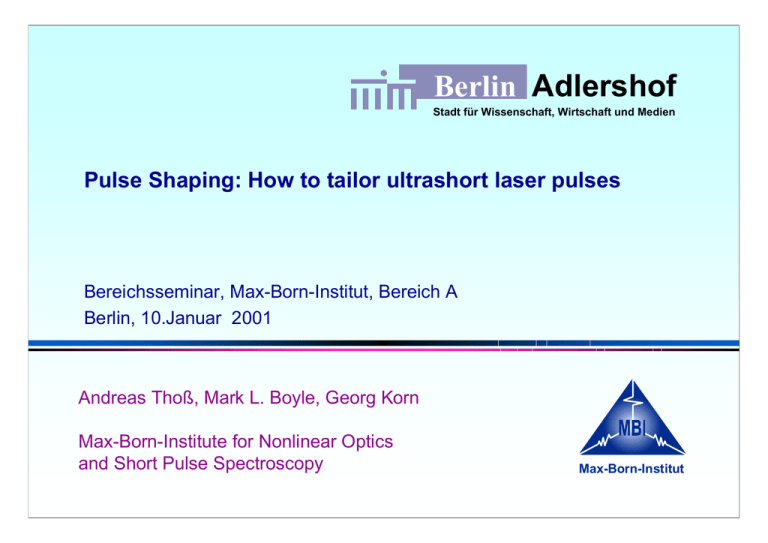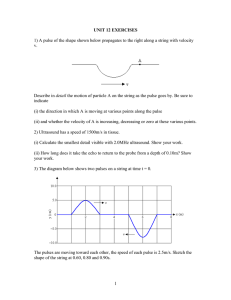Phase modulation
advertisement

Berlin Adlershof
Stadt für Wissenschaft, Wirtschaft und Medien
Pulse Shaping: How to tailor ultrashort laser pulses
Bereichsseminar, Max-Born-Institut, Bereich A
Berlin, 10.Januar 2001
Andreas Thoß, Mark L. Boyle, Georg Korn
Max-Born-Institute for Nonlinear Optics
and Short Pulse Spectroscopy
Max-Born-Institut
Outline
•
•
•
•
•
•
•
Motivation: Why to tailor short pulses?
Overview: Pulse shaping devices
Liquid-Crystal-Modulator for active phase control
Dispersion control and pulse optimization
Generation of tailored pulse shapes
Simultanous phase and amplitude shaping
Applications of shaped pulses
Max-Born-Institut, Andreas Thoss - 10.01.01
2
Introduction
• Pulse shaping: active control of spectral phase and amplitude of
ultrashort laser pulses
• Femtochemistry: experiments on quantum control with shaped laser
pulses or pulse sequences
• Optimization of lasersystems (phase or dispersion control, very short
pulses)
• Further applications in fields like telecommunications, microscopy etc.
Max-Born-Institut, Andreas Thoss - 10.01.01
3
Femtochemistry: Selectivly fragmentation of molecules
• Control of chemical Reactions by Feedback-Optimized Phase-Shaped
Femtosecond Laser Pulses
A. Assion, T. Baumert, M. Bergt, T. Brixner, B. Kiefer, V. Seyfried, M. Strehle, G.
Gerber, Science 282, 919 (1998)
CpFe(CO)2Cl (dicarbonylchloro(η5-cyclopentadienyl)iron
- Molecule incorporates different types of chemical metal-ligand bonds
( Fe-CO, Fe-Cp, Fe-Cl)
- some possible fragmentation channels:
•
•
to CpFeCoCl+ by cleavage of one of the Fe-CO-bonds
to FeCl+ by removing the carbonyl-ligands as well as the Cp ligand
⇒ two different bond breaking reactions
Max-Born-Institut, Andreas Thoss - 10.01.01
4
Experiment: Fragmentation by optimized shaped pulses
First Test: Maximize CpFeCoCl+ / FeCl+ - branching ratio (solid blocks in fig.)
Second Test: Minimize CpFeCoCl+ / FeCl+ - branching ratio (open blocks)
Max-Born-Institut, Andreas Thoss - 10.01.01
5
Results and Laser pulses
Fig.: Interferrometric laser pulse
autocorrelations
Branching ratio
A) in maximization experiment
B) in minimization experiment
C) with bandwidth limited pulse
4.9
1.2
2.4
arbitrarily long pulses (ps) no
optimum ratio neither
Max-Born-Institut, Andreas Thoss - 10.01.01
6
Overview: Pulse shaping devices
• Pulse shaping: Manipulation of spectral phase or amplitude of
ultrashort pulses
• Common devices:
!
!
!
!
Simple slits, masks, etalons etc. (passive control)
Deformable mirrors
Acousto optical modulators
Liquid Crystal devices
Max-Born-Institut, Andreas Thoss - 10.01.01
7
Deformable mirrors
• Zeek et al. Opt. Lett. 25, 587 (2000), „Adaptive pulse compression for
transform-limited 15-fs high-energy pulse generation“
• Pulse shaper just after stretcher, Optimization with evolutionary algorithm
• small number of mirror elements (19 in this example)
• High price
Max-Born-Institut, Andreas Thoss - 10.01.01
8
Acousto-optical devices 1: transversal grating
• M.A. Dugan, J.X. Tull, W.S. Warren,
JOSA B 14, 2348 (1997), „Highresolution acousto-optic shaping of
unamplified and amplified femtosecond
laser pulses“
• Continuous phase and amplitude mask
(no pixelation)
• Low diffraction efficiency
• Large aperture crystal necessary
Max-Born-Institut, Andreas Thoss - 10.01.01
9
Acousto-optical devices 2: longitudinal grating
(DAZZLER)
• F. Verluise, V. Laude, Z. Cheng, Ch. Spielmann, P. Tournois, Opt. Lett. 25, 575
(2000), „Amplitude and phase control of ultrashort pulses by use of an acoustooptic programmable dispersive filter: pulse compression and shaping“
• Collinear interaction between RF-signal and Laser pulse
• Compact, easy to handle, no zero-dispersion stretcher necessary
Max-Born-Institut, Andreas Thoss - 10.01.01
10
Liquid Crystal Modulator
f
f
f
f
• Design considerations
Grating and lens define spectral
extent on the LCM
➪ Grating defines spectral resolution
➪
Liquid
Crystal
Modulator
Max-Born-Institut, Andreas Thoss - 10.01.01
• Prisms instead of gratings (higher
efficiency) also possible, but
preferably for broad spectra
11
Liquid Crystal Modulator – look inside
•Modulator consists of 128 LC-pixels
•Each is 97 µm x 2 mm
ao
B
c
frn
e
R
m
a
l
e
s
tifrC
n
s4
o
kd
c
L
d
ilM
a
D
n
r75
e
w
P
tp
u
O
re
h
p
a
i:S
T
,fs
W
m
3ixM
i In
P
6
5
2
a
ls
rtu
te
u
p
m
o
C
0
ld
p
m
A
n
s
a
h
P
e
d
iy
s
te
~
m
5
8
tr7
n
e
lC
D
,0
w2
o
P
u
lfO
p
m
A
tiv
ra
n
g
e
R
s
ro
C
W
Close-Up View of Pixel Arrangement
14,8mm
0
1
2
3
4
2mm
97µm
0
Max-Born-Institut, Andreas Thoss - 10.01.01
127
100 µm
12
Phase Modulation using Liquid Crystals
• Liquid Crystals oriented along y-axis
• Apply voltage V to the crystals of one pixel
• Liquid Crystals tilt, optical path length in this
pixel gets longer for light polarized along yaxis, therefore variable retardation possible
•
phase Φ(ω) is shifted:
∆Φ(ω)=z*∆n(V)∗ω/ c0
– z…thickness of modulator
– ∆n(V) … LC-birefringence, I.e. Voltage
dependent difference in index of refraction
between the two axis x and y of the Liquid
Crystal
Max-Born-Institut, Andreas Thoss - 10.01.01
13
Basic principles of phase and amplitude modulation
• Phase modulation: one array, incident light polarized along tilt axis of
the liquid crystals (c-axis)
• Filter:
Bk = exp(i*Φmod(ωk))
• Amplitude modulation: the c-axis of LCs is tilted 45° to the incident
light polarization ex
• Filter:
Bk = exp[i*Φmod / 2] × { ex*cos[Φmod/2] + i*ey*sin[Φmod/2] }
• After array is a polarizer placed parallel to incident light polarization ex
• Filter:
Bk = exp[i*Φmod / 2] × cos[Φmod/2]
• Filter for two consecutive arrays (-45° and 45° tilted to inc. light polar.)
Bk = exp{i [ ∆Φ(1) + ∆Φ(2) ] / 2}cos { [ ∆Φ(1) - ∆Φ(2) ] / 2}
Max-Born-Institut, Andreas Thoss - 10.01.01
14
Simultanuous phase and amplitude modulation
Example: Amplitude modulation in one pixel k with phase shift compensation
Imagine: 2-array modulator, the first array for amplitude shaping and the
second for phase shaping only
• First array makes amplitude modulation
⇒
⇒
⇒
pattern is ∆Φ(1) i = (0 if i≠k and α if i=k)
Spectral component ωkis retarded with α and attenuated by cos(α)
All other spectral components ωi≠k are not retarded
• Second array makes phase modulation
⇒
pattern is ∆Φ(2) i = (α if i≠k and 0 if i=k)
• Result: all spectral components have equal phase but I(ωk) is attenuated
Max-Born-Institut, Andreas Thoss - 10.01.01
15
Temporal and phase limitations
• Shortest possible pulse: not less than bandwidth limited (no non-linear
processes incide the modulator)
• Smallest temporal feature (temporal resolution): 16 fs (our setup)
➪
Depends on: grating constant, focal length, diffraction angle in the 4-fsetup and on the center wavelength of the incident pulse
• Longest temporal feature: 2 ps (our setup)
➪
➪
This describes the modulation limit. Outside this range replica can appear.
Origin of replica: diffractive effects in the LCM, non linear processes in
amplification systems
• Maximum phase shift (phase shift limitation):
➪
➪
Physical limit of liquid crystals is about 6 π
Practical limit 128*2* π, because of interference effect
Max-Born-Institut, Andreas Thoss - 10.01.01
16
LCM – real world setup
Grating
Grating
Spherical
Mirror
f=15 cm
Plane
Mirror
20 fs in
Max-Born-Institut, Andreas Thoss - 10.01.01
Plane
Mirror
Polarizer
Polarizer
Spherical
Mirror
f=15 cm
30 fs out
with phase
modulation
17
Photo LCM Setup
Max-Born-Institut, Andreas Thoss - 10.01.01
18
Applications of pulse shaping devices
• Phase dispersion control (pure phase modulation)
⇒
⇒
Pulse shortening
General pulse length control
• Temporal Pulse shaping (phase and/or amplitude modulation
⇒
⇒
multiple pulses (double pulse... Pulse train) with adjustable distance
Tailoring special pulse shapes according to experiments
• Adaptive pulse shape optimization
⇒
Self-organizing algorithms find optimized pulse shapes using computer
algorithms from artificial intelligence
Max-Born-Institut, Andreas Thoss - 10.01.01
19
Dispersion control and pulse optimization (Phase
modulation)
• Phase Dispersion:
Φ(ω) = Φ(ω0) + Φ' (ω0)*(ω-ω0) + Φ'' (ω0)*(ω-ω0)² +
+ Φ''' (ω0)*(ω-ω0)³
+ higher order terms ....
• Spectral phase shaping
Modulator applies phase shift (Pixel No k): Φmod(ωk) = z*n(Vk)∗ωk/ c0
Phase filter for pixel k
Phase modulation
Max-Born-Institut, Andreas Thoss - 10.01.01
Bk = exp(i*Φmod(ωk))
Emod(ωk) = E(ωk) * exp(i*Φmod(ωk))
20
Setup for optimization of amplified pulses
Optimized Amplified
Pulses
Auto/Cross
correlator
Laser
Oscillator
LC Pulse
Shaper
Max-Born-Institut, Andreas Thoss - 10.01.01
SPIDER
Chirped Pulse Amplification
System
21
Chirped Pulse Amplification System – Specifications
• Commercial Spitfire System from Spectra Physics, Inc.
• Includes Stretcher, Regenerative Amplifier, 2 Pass Post amplifier,
Compressor
• Parameter:
➪
➪
➪
➪
➪
Repetition rate
Max. Pulse Energy
Wavelength
Bandwidth
Pulse Length
Max-Born-Institut, Andreas Thoss - 10.01.01
1 kHz
2 mJ
780 nm
40 nm
50 fs
22
Laser pulse shape before and after amplification
AC: τ AC = 30 fs
Initial Oscillator Pulse
Pulse Length 20 fs
-120 -100 -80
-60
-40
-20
0
20
40
60
80
100 120
Time in fs
Amplified Pulse
-600
Max-Born-Institut, Andreas Thoss - 10.01.01
-400
-200
0
200
400
600
23
Third Order Pulse Optimization of
Amplified Pulses with the Pulse Shaper
(SPIDER-Curves)
Initial Pulse
-600
-400
-200
0
200
400
600
-200
0
200
400
600
-200
0
200
400
600
- 100 000 fs³
-600
-400
+100 000 fs³
-600
-400
Time [Femtoseconds]
Max-Born-Institut, Andreas Thoss - 10.01.01
Phase Behaviour after Pulse
Modulation (SPIDER-Measurement)
20
15
10
Initial Pulse Phase
5
0
-5
-10
Phase [RAD]
20
15
10
-100 000fs³
5
0
-5
-10
20
15
10
+ 100 000 fs³
5
0
-5
-10
770
780
790
800
Wavelength [nm]
Max-Born-Institut, Andreas Thoss - 10.01.01
810
820
Optimization using artificial intelligence programs
Oscillator
Modulator
Amplifier
Experiment
I.e. Autocorrelation
Measurement
Computer
Control
of Shaper
Max-Born-Institut, Andreas Thoss - 10.01.01
I.e. SHG
Adaptive
Algorithm
Feedback Signal
26
Optimization using a Genetic Algorithm
Normalized Intensity
1,0
0,9
0,8
0,7
AC FW HM
80 fs
590 fs
76 fs (τ =50fs)
Pulse before Detuning
Detuned
O ptim ized
0,6
0,5
0,4
0,3
0,2
0,1
0,0
-0,1
-1000
-750
-500
-250
0
250
500
750
1000
Fem toseconds
Max-Born-Institut, Andreas Thoss - 10.01.01
27
Advanced pulse shaping: Generation of tailored pulse
shapes
• Now two arrays indepently working plus polarizer enable simultaneous
phase and amplitude shaping
• Phase
• Transmission
(RI … retardance
Φ = π/λ * (Ra2(V2) + Rb1(V1))
T = cos2 [π/λ * (Ra2(V2) - Rb1(V1))]
Vi …LC-Voltage)
Spectral Modulation:
Emod = E * exp[i*1/2*(Φ1mod+Φ2mod) * cos [1/2*(Φ1mod-Φ2mod)]
Pure phase modulation: equal modulation patterns on both arrays
Pure amplitude modulation: modulation patterns with opposite signs
Max-Born-Institut, Andreas Thoss - 10.01.01
28
Cross Correlation of several
Phase Modulated Pulses
-750
-500
-250
0
250
500
750
-750
-500
-250
0
250
500
750
-2000
-1000
0
1000
Tim e [Fem toseconds]
Max-Born-Institut, Andreas Thoss - 10.01.01
2000
Pure amplitude modulation
Spectral Intensity
Imod (ωk) = I (ωk) * cos2 [1/2*(Φ1mod-Φ2mod)]
720
740
760
780
800
820
840
860
W avelength
-750
-500
-250
0
250
500
750
Femtoseconds
Max-Born-Institut, Andreas Thoss - 10.01.01
30
Amplified Modulated Pulses: Pulse train
1,0
Amplified
Unamplified
Normalized Intensity
0,9
0,8
0,7
0,6
0,5
0,4
0,3
0,2
0,1
0,0
-1000
-800
-600
-400
-200
0
200
400
600
800
1000
Femtoseconds
Max-Born-Institut, Andreas Thoss - 10.01.01
31
Outlook and current projects
• Application of shaped pulses (equidistant sequences) in spectroscopic
experiments
• Adaptive pulse optimization and amplitude broadening for the amplifier
• Material processing
• Further amplification of optimized pulses and generation of X-ray
pulses
Max-Born-Institut, Andreas Thoss - 10.01.01
32




